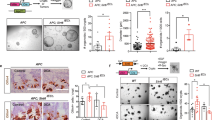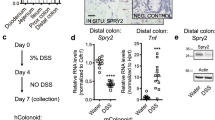Abstract
Sodium butyrate (NaB) inhibits proliferation, stimulates apoptosis, and promotes differentiation of human colon cancer cells along the absorptive phenotype. In vitro, butyrate induces a switch from cells with a secretory to an absorptive phenotype. Here, we report that NaB specifically represses the expression of the MUC2 gene, a differentiation marker of the secretory goblet cell lineage, in forskolin- and 12-O-tetradecanoylphorbol 13-acetate-induced HT29 cells, and Cl.16E cells, a clonal derivative of HT29 cells that spontaneously differentiates into goblet cells. Thus, NaB repression is independent of the nature of the stimulus that triggers MUC2 expression. Further, repression was independent of new protein synthesis. Our results suggest that inhibition of MUC2 is linked to the ability of butyrate to repress histone deacetylase activity, since trichostatin A, another inhibitor of histone deacetylases, also inhibited MUC2 expression in induced HT29 cells. Finally, we demonstrate that the NaB effect is specific for this marker of the secretory cell lineage, since carcinoembryonic antigen, which is expressed in both the secretory and absorptive cells, is induced by NaB. Thus, the NaB repression of a definitive function of the secretory cell lineage is a further mechanism, in addition to the effects on proliferation and apoptotic pathways, through which butyrate can regulate intestinal homeostasis.
This is a preview of subscription content, access via your institution
Access options
Subscribe to this journal
Receive 50 print issues and online access
$259.00 per year
only $5.18 per issue
Buy this article
- Purchase on Springer Link
- Instant access to full article PDF
Prices may be subject to local taxes which are calculated during checkout








Similar content being viewed by others
Abbreviations
- F:
-
forskolin
- HDAC:
-
histone deacetylase
- ITF:
-
intestinal trefoil factor
- MEK-1:
-
mitogen-activated protein kinase kinase-1
- NaB:
-
sodium butyrate
- TSA:
-
trichostatin A
- TPA:
-
12-O-tetradecanoylphorbol 13-acetate
References
Allen A, Hutton DA and Pearson JP . (1998). Int. J. Biochem. Cell Biol., 30, 797–801.
Augenlicht L, Anthony GM, Church TL, Edelman W, Kucherlapati R, Yang K, Lipkin M and Heerdt B . (1999). Cancer Res., 59, 6005–6009.
Augenlicht L, Augeron C, Yander G and Laboisse C . (1987). Cancer Res., 47, 3763–3765.
Augeron C and Laboisse C . (1984). Cancer Res., 44, 3961–3970.
Bradbury EM . (1992). Bio Essays, 14, 9–16.
Braunstein M, Sobel RE, Allis CD, Turner BM and Broach JR . (1996). Mol. Cell. Biol., 16, 4349–4356.
Chang SK, Dohrman AF, Basbaum CB, Ho SB, Tsuda T, Toribara NW, Gum JR and Kim YS . (1994). Gastroentrology, 107, 28–36.
Csordas A . (1990). Biochem J., 265, 23–38.
Csordas A . (1995). Role of Gut Bacteria in Human Toxicology and Pharmacology. Hill MJ (ed). Taylor & Francis: London, pp 105–127.
Cuisset L, Tichonicky L and Delpech M . (1998). Biochem. Biophys. Res. Commun., 243, 760–764.
Cuisset L, Tichonicky L, Jaffray P and Delpech M . (1997). J. Biol. Chem., 272, 24148–24153.
De Rubertis F, Kadosh D, Henchoz S, Pauli D, Reuter G, Struhl K and Spierer P . (1996). Nature, 384, 589–591.
Debailleul V, Laine A, Huet G, Mathon P, Collyn d'Hooge M, Aubert JP and Porchet N . (1998). J. Biol. Chem., 273, 881–890.
Espinos E, Le Van Thai A, Pomies C and Weber M . (1999). Mol. Cell. Biol., 19, 3474–3484.
Gum J, Kam W, Byrd J, Hicks J, Sleisenger M and Kim YS . (1987). J. Biol. Chem., 262, 1092–1097.
Hague A, Singh B and Paraskeva C . (1997). Gastroenterology, 112, 1036–1040.
Hass R, Busche R Luciano L and Reale E . (1997). Gastroenterology, 112, 875–881.
Heerdt B, Houston M and Augenlicht L . (1994). Cancer Res., 54, 3288–3294.
Hill MJ . (1995). Eur. J. Cancer Prev., 4, 353–358.
Iacomino G, Tecce M, Grimaldi C, Tosto M and Russo G . (2001). Biochem. Biophys. Res. Commun., 285, 1280–1289.
Ilantzis C, Jothy S, Alpert L, Draber P and Stanners C . (1997). Lab. Invest., 76, 703–716.
Jarry A, Merlin D, Velcich A, Hopfer U, Augenlicht L and Laboisse C . (1994). Eur. J. Pharm., 267, 95–103.
Laboisse C . (1989). Cell and Molecular Biology of Colon Cancer. Augenlicht LH (ed). CRC Press: Boca Raton, FL, pp 27–43.
Lee HW, Ahn DH, Crawley SC, Li JD, Gum Jr JR, Basbaum, CB, Fan NQ, Szymkowski DE, Han SY, Lee BH, Sleisenger MH and Kim YS . (2002). J. Biol. Chem., 277, 32624–32631.
Mariadason J, Corner G and Augenlicht L . (2000). Cancer Res., 60, 4561–4572.
Matthews JB, Hassan I, Meng S, Archer S, Hrnjez B and Hodin RA . (1998). J. Clin. Invest., 101, 2072–2079.
Nap M, Mollgard K, Burtin P and Fleuren G . (1988). Tumor Biol., 9, 145–153.
Paulus U, Loefler M, Zeidler J, Owen G and Potten C . (1993). J. Cell Sci., 106, 473–484.
Perrais M, Pigny P, Copin MC, Aubert JP and Van Seuningen I . (2002). J. Biol. Chem., 277, 32258–32267.
Rowe WA and Bayless TM . (1992). Gastroenterology, 103, 336–339.
Scheppach W . (1994). Gut, 35, S35–S38.
Sealy L and Chalkley R . (1978). Cell, 14, 115–121.
Singh B, Halestrap AP and Paraskeva C . (1997). Carcinogenesis, 18, 1265–1270.
Taupin D and Podolsky D . (1999). Gastroenterology, 116, 1072–1080.
Tran C, Familari M, Parker L, Whitehead R and Giraud A . (1998). Am. J. Physiol.##G85–G94.
Turner BM, Birley AJ and Lavander J . (1992). Cell, 69, 375–384.
Velcich A and Augenlicht L . (1993). J. Biol. Chem., 268, 13956–13961.
Velcich A, Palumbo L, Jarry A, Laboisse C, Racevskis J and Augenlicht L . (1995). Cell Growth Differ., 6, 749–757.
Velcich A, Palumbo L, Seller L, Evans G and Augenlicht L . (1997). J. Biol. Chem., 272, 7968–7976.
Velcich A, Yang W, Heyer J, Fragale A, Nicholas C, Viani S, Kucherlapati R, Lipkin M, Yang K and Augenlicht LH . (2002). Science, 295, 1726–1729.
Waltzer L and Bienz M . (1998). Nature, 395, 521–524.
Weiss A, Babyatsky M, Ogata S, Chen A and Itzkowitz S . (1996). J. Histochem. Cytochem., 44, 1161–1166.
Wu J, Archer S, Hinnebusch B, Meng S and Hodin R . (2001). Am. J. Physiol., 280, G482–G490.
Yoshida M, Kijima M, Akita M and Beppu T . (1990). J. Biol. Chem., 265, 17174–17179.
Acknowledgements
This work was supported in part by Grants CA-90808, CA-68965, and P30CA-13330. We thank Lidija Klampfer for critical reading of the manuscript.
Author information
Authors and Affiliations
Corresponding author
Rights and permissions
About this article
Cite this article
Augenlicht, L., Shi, L., Mariadason, J. et al. Repression of MUC2 gene expression by butyrate, a physiological regulator of intestinal cell maturation. Oncogene 22, 4983–4992 (2003). https://doi.org/10.1038/sj.onc.1206521
Received:
Revised:
Accepted:
Published:
Issue Date:
DOI: https://doi.org/10.1038/sj.onc.1206521
Keywords
This article is cited by
-
A bridge for short-chain fatty acids to affect inflammatory bowel disease, type 1 diabetes, and non-alcoholic fatty liver disease positively: by changing gut barrier
European Journal of Nutrition (2021)
-
Obesity during pregnancy results in maternal intestinal inflammation, placental hypoxia, and alters fetal glucose metabolism at mid-gestation
Scientific Reports (2019)
-
Dysregulation of histone deacetylases in carcinogenesis and tumor progression: a possible link to apoptosis and autophagy
Cellular and Molecular Life Sciences (2019)
-
Colonic MUC2 mucin regulates the expression and antimicrobial activity of β-defensin 2
Mucosal Immunology (2015)
-
Bacteroides thetaiotaomicron and Faecalibacterium prausnitziiinfluence the production of mucus glycans and the development of goblet cells in the colonic epithelium of a gnotobiotic model rodent
BMC Biology (2013)



